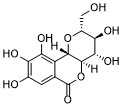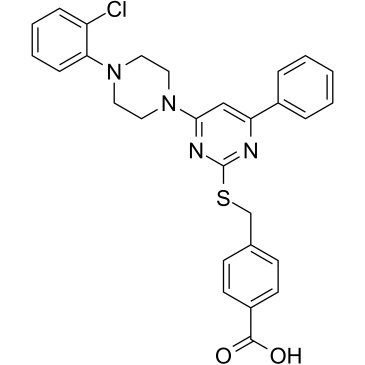 To enhance service speed and avoid tariff delays, we've opened a US warehouse. All US orders ship directly from our US facility.
To enhance service speed and avoid tariff delays, we've opened a US warehouse. All US orders ship directly from our US facility.
| Cat. No. | Product Name | Field of Application | Chemical Structure |
|---|---|---|---|
| DC76720 | Vitamin E nicotinate |
Vitamin E nicotinate is the derivative of Vitamin E. Vitamin E nicotinate exhibits antioxidant activity and prevents lipid peroxidation. Vitamin E nicotinate upregulates levels of CD4+ T cells and IL-2, exhibits immunomodulatory activity. Vitamin E nicotinate exhibits antiplatelet and antihypertensive activities, that can be used in atherosclerosis and thrombosis ressearch.
More description
|

|
| DC76719 | SP11 |
SP11 is a mitochondrial reactive oxygen species (ROS) inhibitor. SP11 activates Fis1 by binding to Cys41 (IC50: 9.4 µM) and increases the translocation of Drp1 to mitochondria. SP11 can be used in studies on the protection against oxidative stress damage.
More description
|

|
| DC76718 | SIN 14 |
SIN 14 is a HO-1 activator that targets and allosterically activates HO-1. SIN 14 induces macrophage polarization from M1 to M2 phenotype.
More description
|

|
| DC76717 | ROS-ERS inducer 2 |
ROS-ERS inducer 2 (Complex 3f) triggers intracellular ROS generation and affect the function of mitochondria. promote the release of damage-associated molecular patterns (DAMPs), induce immunogenic cell death (ICD) and activates endoplasmic reticulum stress (ERS). ROS-ERS inducer 2 plays an important role in anti-liver cancer research.
More description
|

|
| DC76716 | ROS inducer 8 |
ROS inducer 8 (Compound 11g) is the inhibitor for glutathione (GSH), that induces the ROS accumulation in Enterococcus faecalis, thereby exhibiting antibacterial activity. ROS inducer 8 disrupts the biofilm, inhibits S. aureus and E. faecalis with MIC of 8 μg/mL and 2 μg/mL, exhibits post-antibiotic effect. ROS inducer 8 exhibits low hemolytic toxicity to sheep erythrocytes (HC50 > 1280 μg/mL).
More description
|

|
| DC76715 | ROS inducer 6 |
ROS inducer 6 (compound 9) is a reactive oxygen species (ROS) inducer. ROS inducer 6 (compound 9) acts as an anticancer agent by inducing ROS generation through the depletion of intracellular glutathione.
More description
|

|
| DC76714 | NPC26 |
NPC26 is a small molecule mitochondrial disruptor with anti-tumor activity. NPC-26 shows significant anti-proliferative and cytotoxic effects on CRC cell lines (HCT-116, DLD-1, and HT-29). NPC26 can damage mitochondrial function, leading to the opening of the mitochondrial permeability transition pore (mPTP) and the production of reactive oxygen species, ultimately inducing cell death. NPC-26 can kill CRC cells by activating the AMP-activated protein kinase (AMPK) signaling pathway.
More description
|

|
| DC76713 | Nitrosobenzene |
Nitrosobenzene is a radical scavenger that can be used to study oxidative DNA damage and the respiratory burst reaction of neutrophils induced by nitro compounds.
More description
|

|
| DC76712 | meso-Zeaxanthin |
meso-Zeaxanthin accumulates in the central retina and forms macular pigment together with lutein and zeaxanthin, which has the function of light filtering. meso-Zeaxanthin can quench ROS and exert antioxidant function.
More description
|

|
| DC76711 | L-Ascorbic acid magnesium |
L-Ascorbic acid (L-Ascorbate) magnesium, an electron donor, is an endogenous antioxidant. L-Ascorbic acid selectively inhibits Cav3.2 channels with an IC50 of 6.5 μM. L-Ascorbic acid is also a collagen deposition promoter and elastin production inhibitor. L-Ascorbic acid exhibits anticancer effects by generating reactive oxygen species (ROS) and selectively damaging cancer cells.
More description
|

|
| DC76710 | Hypoxystat |
Hypoxystat increases the affinity of hemoglobin for oxygen and reduces the release of oxygen to tissues, thereby inducing the tissue hypoxia. Hypoxystat alleviates the mitochondrial disease Leigh syndrome in Ndufs4 knockout mouse models. Hypoxystat exhibits orally activity.
More description
|

|
| DC76709 | DIM-C-pPhtBu |
DIM-C-pPhtBu is an orally active endoplasmic reticulum stress activator. DIM-C-pPhtBu induces mitochondrial and lysosome dysfunction, excessive mitosis, ROS production, and unfolded protein response-mediated cell death in neck cancer cells. DIM-C-pPhtBu has antitumor activity.
More description
|

|
| DC76708 | Cyanidin arabinoside |
Cyanidin arabinoside is an antioxidant agent, that exhibits a Trolox and can be used to prepare ADC compounds.
More description
|

|
| DC76707 | BJ-13 |
BJ-13 is a reactive oxygen species (ROS) inducer that can lead to mitochondrial membrane potential collapse and caspase-dependent apoptosis. BJ-13 inhibits the proliferation of SGC-7901, U-87MG, and HepG-2 cancer cells (IC50 values of 15.33, 27.18, and 20.44 nM, respectively). BJ-13 can be used in the study of gastric cancer.
More description
|

|
| DC76706 | (+)-Secolongifolene-diol |
(+)-Secolongifolene-diol is a sesquiterpene, that can be isolated from the marine fungal Drechslera sp. (+)-Secolongifolene-diol exhibits slightly weak effectiveness in antioxidation, antimicrobial and antifouling aspects.
More description
|

|
| DC45577 | Norbergenin Featured |
Norbergenin, the O-demethyl derivative of bergenin, shows moderate antioxidant activity (IC50 13 μM in DPPH radical scavenging; 32 μM in superoxide anion scavenging).
More description
|

|
| DC72835 | Didocosahexaenoin |
Didocosahexaenoin, an omega-3 derivative, is a diglyceride of DHA and can be synthesised from DHA triglycerides. Didocosahexaenoin causes significant loss of mitochondrial membrane potential and induces ROS production. Didocosahexaenoin induces apoptosis. Didocosahexaenoin induces stronger cytotoxicity than DHA in human prostate carcinoma cells.
More description
|

|
| DC72647 | QD394 |
QD394 is a reactive oxygen species (ROS) inducer that can induce lipid peroxidation, increase intracellular ROS accumulation, inhibit STAT3 phosphorylation, and induce ferroptosis.
More description
|

|
| DC72354 | Mal-Pc |
Mal-Pc is a versatile molecular photosensitizer designed based phthalocyanine and maleimides. Mal-Pc can react with GSH to deplete GSH and reduce aggregation, thereby improving ROS (Reactive Oxygen Species)-mediated effect of photodynamic therapy (PDT) in cancer cells.
More description
|

|
| DC72353 | CM-H2DCFDA |
CM-H2DCFDA is a derivative of H2DCFDA. CM-H2DCFDA can be used to determine cellular oxidant levels (Ex/Em: 495/530 nm). CM-H2DCFDA is light-sensitive.
More description
|

|
| DC72209 | MnTE-2-PyP chloride |
MnTE-2-PyP (BMX-010) chloride is a ROS scavenger and potent radioprotector. MnTE-2-PyP also is a manganese porphyrin, protects normal prostate tissue from radiation damage. MnTE-2-PyP can be used for the research of diabetic prostate cancer.
More description
|

|
| DC71793 | o-Hydroxybenzylamine |
o-Hydroxybenzylamine (2-HOBA) a selective dicarbonyl scavenger, is an antioxidant and scavanger of free radicals and isolevuglandins (IsoLGs). o-Hydroxybenzylamine can be used in the research of inflammation and cardiovascular disease, such as atherosclerosis, early recurrence of atrial fibrillation (AF) and arrhythmias.
More description
|

|
| DC71792 | Epoetin delta |
Epoetin delta is a recombinant human erythropoietin. Epoetin delta could protect human renal tubular epithelial cells against oxidative stress by a dose-dependent inhibition of reactive oxygen species (ROS) formation. Epoetin delta can be used for the research of anaemia and kidney diseases. Epoetin Delta also exhibits antifibrotic activity in the remnant kidney rat model.
More description
|

|
| DC71532 | Topramezone |
Topramezone is a potent 4-hydroxyphenylpyruvate dioxygenase (4-HPPD) inhibitor. Topramezone is a herbicide, used for the post-emergence control of broadleaf and grass weeds in corn.
More description
|

|
| DC71357 | Cedrin |
Cedrin is a natural flavonoid that can be found in Cedrus deodara. Cedrin protects PC12 cells against neurotoxicity induced by Aβ1-42. Cedrin can reduce reactive oxygen species overproduction, increase the activity of superoxide dismutase and decrease malondialdehyde content.
More description
|

|
| DC28756 | J14 Featured |
J14 is a reversible sulfiredoxin inhibitor with an IC50 of 8.1 μM. J14 induces oxidative stress (intracellular ROS accumulation) by inhibiting sulfiredoxin, leading to cytotoxicity and cancer cell death.
More description
|

|
| DC71106 | Pyocyanin |
Pyocyanin (Pyocyanine) is a phenazine that is a toxic, quorum sensing (QS)-controlled metabolite produced by P. aeruginosa. Pyocyanin is a redox-active compound and promotes the generation of reactive oxygen species (ROS). Pyocyanin also possesses antibacterial properties and increases fitness in competition with other bacterial species.
More description
|

|
| DC49683 | Hydroxyphenyl Fluorescein |
Hydroxyphenyl fluorescein (HPF) is the reagent that can directly detect highly reactive oxygen species (hROS). Hydroxyphenyl fluorescein selectively and dose-dependently reacts with hROS, such as the hydroxyl radical and peroxynitrite, which exhibit strong fluorescence.
More description
|

|
| DC49682 | RIDR-PI-103 |
RIDR-PI-103 is a reactive oxygen species (ROS)-induced drug release prodrug with a self-cyclizing moiety linked to a pan-PI3K inhibitor (PI-103).
More description
|

|
| DC49681 | L-Ascorbic acid-13C |
L-Ascorbic acid-13C (L-Ascorbate-13C) is the 13C-labeled L-Ascorbic acid. L-Ascorbic acid (L-Ascorbate), an electron donor, is an endogenous antioxidant agent. L-Ascorbic acid inhibits selectively Cav3.2 channels with an IC50 of 6.5 μM. L-Ascorbic acid is also a collagen deposition enhancer and an elastogenesis inhibitor. L-Ascorbic acid exhibits anti-cancer effects through the generation of reactive oxygen species (ROS) and selective damage to cancer cells.
More description
|

|